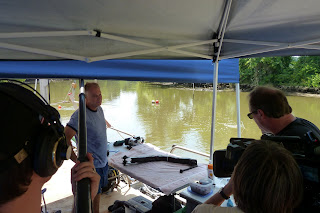By Michael English, Producer
(On the river near Wayson's Corner, Md.) -- At low tide here, a white stripe dries pale and jagged on shoreline river brush, looking a little like it was painted on. For those who know, it tells the important tale of the last Patuxent high tide. It's an easy code to break. It simply remembers the most recent high water mark -- a convenient reminder of a never-ending cycle that drops the river nearly two feet in just a few hours. Pay no attention, and you can find yourself high and dry on river mud, waiting.
In the afternoon, Videographer Marlene Rodman was busy composing shots of shoreline mud flats when Bob Neyland suddenly surfaced. I could see he had something. Marlene swung around to catch the shot. Just then, someone switched off the lone dredge pump that was keeping sediment from re-blanketing the wreck's bow section. Now it was possible to capture audio as well, and Audio Engineer Gordon Masters extended his fish pole to catch it all.
We'd been waiting for Neyland. He'd been in the water for nearly an hour, accompanied by fellow Principal Investigator Julie Schablitsky. We learned later they had worked carefully, methodically -- almost tediously -- in the murky water to free a part of the wreck that was loose and in danger of being swept away by the Patuxent's relentless current. Now, Neyland floated it gently along the surface to the barge ladders, then passed it up. It was brought aboard and immediately measured, drawn, cataloged and then re-immersed in riverwater to keep it from the open air.
Exactly what it is has yet to be determined, but Neyland believes it could be a Cathead -- a large piece of wood angled at 45 degrees that helps to hold a ship's anchor in place. But this wasn't an artifact from just any ship. This ship could possibly be the USS Scorpion -- Joshua Barney's flagship during the War of 1812. It was an exciting discovery -- the first identifiable piece of the ship itself that the crew and I had seen in our three days aboard the barge. Busy as he was, Neyland gave us a good interview describing conditions below and the work it took to free the artifact from the wreck but, then -- like all of them -- so busy here at this site from morning until evening, he and the rest of his archeological team moved on to the next artifact to be cataloged, drawn or conserved. This afternoon's discovery was special, yes, but there was more to be done and little time to do it.
But for us -- the uninitiated, witnessing history as it's made and getting caught up in it all -- it feels a little like a whisper from August 22, 1814, the last time our mystery ship sailed this winding channel and its brave sailors, with enemies nearby, kept a close eye on the tide line.
Maryland Public Television is documenting the excavation of a submerged site in the Patuxent River by an archeological team that is trying to learn whether or not the ship is the U.S.S. Scorpion -- flagship of Commodore Joshua Barney's famed War of 1812 flotilla that is believed to have been scuttled and sunk on the site. The documentary, "Search for the USS Scorpion," will be broadcast in the Fall of 2012. Check here for updates on what producers are finding...
Thursday, August 4, 2011
Wednesday, August 3, 2011
The Murky Patuxent Keeps Its Secrets Close
It's like swimming in a blizzard. That's what local underwater cinematographer Nick Caloyianis said about his recent dive into the murky waters of the Patuxent River to capture HD video footage of the Scorpion and its excavation site.
Caloyianis usually dives in water with considerably more clarity, and his underwater photographic subjects most of the time are sharks of the large and hungry variety. Recently, he was photographing Great White sharks off the coast of New England for a television project.
But his interests in marine cinematography extend beyond sharks. As a Maryland native, Caloyianis is an expert on life in the Chesapeake Bay -- something he's been shooting with a camera for decades. He is a regular videographic contributor to Maryland Public Television nature documentary projects and produces segments for MPT's popular Outdoors Maryland series.
Last Friday, though, he donned his mask, flippers and airtank with one goal in mind: to record the excavation of the vessel that may be the USS Scorpion. With dredge pumps pounding away on the barge topside, Caloyianis felt his way along the river bottom until he found the wreck. With his state-of-the-art camera inside of a custom metal case, he spent about six hours in the water photographing the wreck.
As any of the divers on the Scorpion project will tell you, visibility at this site is all but impossible to predict. Caloyianis reports that his dive, though successful, was marred by the severe thunderstorms that blew through a few days before. Runoff from the downpour carried heavy sediment downriver to the excavation site. The effect was, as Caloyianis and other divers attested, like swimming in a snowstorm.
Though the conditions were unfavorable, Caloyianis says he did get some clean video and still photos of the wreck -- some of which MPT viewers will be able to see when this documentary airs in 2012.
Subscribe to:
Posts (Atom)






